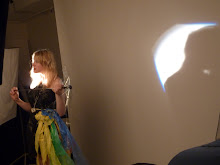
Saturday, October 3, 2009
Thursday, October 1, 2009
Wednesday, September 30, 2009
Tuesday, September 29, 2009
Sunday, September 27, 2009
My Home of the Future
My home of a future is set in 50 years time where we have inhabited most of the earth and have started to colonise the seas. Most buildings are connected to the sea floor so they don’t move, except in the smaller unpopulated areas: a bit like today’s city and country. Of course there is still land based cities but on land that’s all there is, cities. All buildings on land have also become very tall and some even extend into the ground to provide more space.
Inside each building on land or sea, is temperature controlled to a living standard. Outside it averages around 50’C-60’C because of global warming with no cool period, rain does fall over the deeper oceans because it is a few degrees cooler.
Because of this unhospitable landscape all food substances are either personally grown inside ones house or is purchased from one of the growing facilities. Clean water is distilled for the sea water in water processing facilities and is kept in tanks according to each building.
Most homes have their own sustainable systems in place for growing food; also a regenerative composting system is used for all personal waste.
Most inhabitants live in small colonies of 8-12 people or in large families, which reduces unpleasant living conditions and having to live with people you don’t know. There are larger, more open buildings (a little bit like malls) where people socialise and usually a school is shared by half a dozen colonies. But most people use the large arboretums that all buildings have for their recreational activities.
All buildings are connected to each other by way of a tub which helps people get from one place to the other, and as everything’s so close you do not have to travel far. Other forms of transport such as trains are provided for people who do need to cover greater distances.
All furniture inside homes is reasonably simple in shape but usually radically decorated.
Colonies spend very little time actually in their homes and usually only gather in the home for evening meals and sleeping. Because of this not much is required in the home itself, most of the home is in fact is taken up by plants that feed the colony.
Most things such as furniture are made out of recycled and processed waste; also metal is used for the buildings shells unless they need to float. Wood is rarely used and the only wood you’ll find is in the arboretums. Cotton and silk are still grown and harvested in some of the colonies so bedding and clothing are relatively the same.
Inside each building on land or sea, is temperature controlled to a living standard. Outside it averages around 50’C-60’C because of global warming with no cool period, rain does fall over the deeper oceans because it is a few degrees cooler.
Because of this unhospitable landscape all food substances are either personally grown inside ones house or is purchased from one of the growing facilities. Clean water is distilled for the sea water in water processing facilities and is kept in tanks according to each building.
Most homes have their own sustainable systems in place for growing food; also a regenerative composting system is used for all personal waste.
Most inhabitants live in small colonies of 8-12 people or in large families, which reduces unpleasant living conditions and having to live with people you don’t know. There are larger, more open buildings (a little bit like malls) where people socialise and usually a school is shared by half a dozen colonies. But most people use the large arboretums that all buildings have for their recreational activities.
All buildings are connected to each other by way of a tub which helps people get from one place to the other, and as everything’s so close you do not have to travel far. Other forms of transport such as trains are provided for people who do need to cover greater distances.
All furniture inside homes is reasonably simple in shape but usually radically decorated.
Colonies spend very little time actually in their homes and usually only gather in the home for evening meals and sleeping. Because of this not much is required in the home itself, most of the home is in fact is taken up by plants that feed the colony.
Most things such as furniture are made out of recycled and processed waste; also metal is used for the buildings shells unless they need to float. Wood is rarely used and the only wood you’ll find is in the arboretums. Cotton and silk are still grown and harvested in some of the colonies so bedding and clothing are relatively the same.
Saturday, September 26, 2009
Subscribe to:
Comments (Atom)














